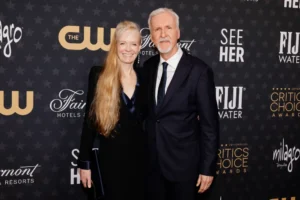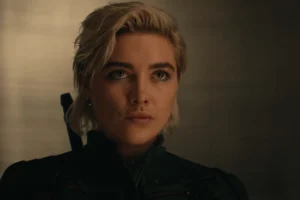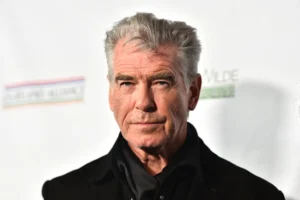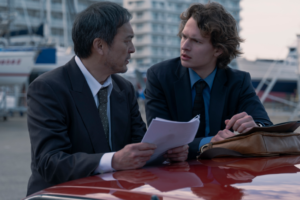(According To The variety) “In the next 45 minutes, we’re about to hear Gus speak more than he has in the last 40 years,” Vito Schnabel, the art world scion who is increasingly turning his head toward Hollywood, told a crowd at New York’s Tribeca Film Festival last week.
He was there to moderate a conversation with American heavyweight filmmaker Gus Van Sant, who just directed Schnabel (and a pack of actors barreling toward Emmy nominations) in “Feud: Capote vs. The Swans.” That history, of a glittery New York whose underbelly was found in the bedrooms and hallways of the ruling class, took a back seat to Van Sant’s impactful career.
He has directed some of the stickiest and profound films of the past four decades, including “Drugstore Cowboy,” “My Own Private Idaho,” the Columbine shooting-inspired “Elephant,” Nicole Kidman’s “To Die For,” the Oscar winner “Milk,” and “Good Will Hunting,” which launched Ben Affleck and Matt Damon into stardom.
Van Sant began as an artist at the Rhode Island School of Design, which made Schnabel a fitting partner for the discussion. The two have exhibited together in Switzerland and share a kind of high-brow shorthand. Read some of our favorite highlights from Van Sant’s body of work. Gus was not the first choice to direct “Good Will Hunting”
“We were doing ‘To Die For’ and Matt Damon came in to audition. I realized he was this guy who had just sold a script, which was unusual for an actor to have sold a script to a studio,” Van Sant remembers. “I got a hold of it when Miramax bought it. I just thought it was great. At the time there were a lot of different people that wanted to [direct] it, but Matt and Ben held out to play their lead parts. Other filmmakers were expecting Leo DiCaprio and Brad Pitt to star in it, and I was the only one left that wanted Ben and Matt. I was pushed aside at first but then brought back in.”
The film fetched a total of nine Academy Award nominations, including a best director nod for Van Sant. Affleck and Damon won best original screenplay, and their costar Robin Williams won best supporting actor. Speaking of …
Robin Williams was indeed in contention to play Harvey Milk.
Van Sant told Schnabel that he had met Williams in 1991 and engaged him about playing trailblazing political and LGBTQ rights pioneer Milk. Williams spoke about looking at the part in the ‘90s, a time when it was considered career suicide for an actor to play an openly gay character. The role ultimately went to Sean Penn decades later and won him an Oscar.
“So, I knew him a little bit,” Van Sant said of Williams when it came time to shoot Damon and Affleck’s film. “It was Harvey Weinstein’s idea to cast Robin, and other actors had said no, but Robin was excited. Maybe because we knew each other.”
“Elephant,” about an inconceivable American tragedy, somehow struck the right note.
One of Van Sant’s masterworks is “Elephant,” the 2003 drama loosely based on the mass shooting at Colorado’s Columbine High School. It follows a cast of unknowns, drifting in and out of their daily grinds as students, until two of their peers arrive at school and execute the crime with no visible emotion.
In his review at the time, critic Roger Ebert noted the film’s depiction of “implacable, poker-faced, flat, uninflected death,” one that would hopefully inspire some soul-searching among the generations that would become affected by this type of violence.
“It was a really particular period of time, right after Columbine, where I remember pitching Barry Diller this project. [Studios] were busy just trying to keep their police shows on the air because of the question of whether that influenced gun shootings in schools,” Van Sant said. “I just wanted to address that as a filmmaker, a problem that was being covered quite liberally by the press and by documentaries but not by fictional creators.”
Schnabel noted Van Sant’s flair for working with amateur actors.
“In the beginning, because I had no money I was always using non-actors. Friends of mine that I knew. I was very good at working with people that weren’t actors. In 2003, when we were making ‘Elephant,’ I thought we really needed to use real high school kids rather than kids that were professionals in L.A. or New York. We held open calls in Portland, Oregon,” the director said. “That was one of the more successful things about that project, those real kids brought part of their real stories during the audition process … that eventually became stories within the film.”
Gus’ White Whale
While Van Sant admitted to “three or four” movies he’s always wanting to make at any given time, one evades him.
“There is one when I first started working that I wanted to make, which was ‘The Electric Kool-Aid Acid Test,’ a book by Tom Wolfe. It was something that we pitched that people didn’t really like because the protagonist is basically dosing college students with LSD without them knowing. It’s a fantastic part of history and a fantastic book.”
















+ There are no comments
Add yours